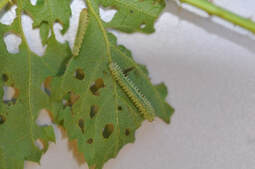 This insect has been feeding on rose leaves in various areas around the state. This is not a caterpillar but is the larva of a sawfly. Close examination of this small (½ inch) larva will reveal very fine, hairlike spines in clusters. Young larvae will remove the green layer of a leaf leaving behind a clear material. This is known as window feeding. As the larvae mature, they make holes in the leaf and eventually may consume all of the leaf but the major veins. Since these insects are not caterpillars (larvae of moths or butterflies), BT, found in Dipel and Thuricide will not be an effective treatment. However, a strong jet of water will dislodge the slugs and make it difficult for them to return to the plant. Other effective treatments include insecticidal soap, horticultural oils, spinosad (Natural Guard Spinosad, Monterey Garden Insect Spray or Captain Jack’s Deadbug Brew) and permethrin (Eight Vegetable, Fruit and Flower Concentrate; Hi-Yield Lawn, Garden, Pet & Livestock Insect Spray). (Ward Upham) 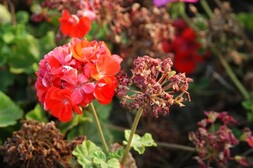 Some plants will bloom more profusely if the old, spent flowers are removed, a process called deadheading. Annuals especially, focus their energy on seed production to insure that the species survives. If you remove old flowers, the energy normally used to produce seed is now available to produce more flowers. Perennials can also benefit by lengthening the blooming season. However, some gardeners enjoy the look of spent flowers of perennials such as sedum or purple coneflower. Also, the seed produced can be a good food source for birds. Not all plants need to be deadheaded, including sedum 'Autumn Joy', melampodium, impatiens, most flowering vines, Lythrum, periwinkle (Catharanthus), and wishbone flower (Torenia). Those that do increase bloom in response to deadheading include hardy geraniums, coreopsis, petunias, marigolds, snapdragons, begonias, roses, campanulas, blanket flowers, delphiniums, zinnias, sweet peas, salvia, scabiosa, annual heliotrope, geraniums (Pelargonium), and yarrow. Deadheading is easily accomplished by removing spent flowers. With some plants, pinching between a thumb and finger can do this, but tough, wiry stems will require a scissors or pruning shears. (Ward Upham) 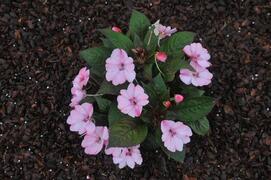 We mentioned sidedressing last week but I wanted to emphasize its importance for annual flowers. Modern annual flowers have been bred to flower early and over a long period of time. They are not as easily thrown off flowering by high nitrogen levels as vegetables are. As a matter of fact, providing nitrogen through the growing season (sidedressing) can help maintain an effective flower display for warm-season flowers. Apply a high nitrogen sidedressing four to six weeks after flowers have been set out. Additional fertilizations every three to four weeks can be helpful during a rainy summer, or if flower beds are irrigated. Common sources of nitrogen-only fertilizers include nitrate of soda, urea, and ammonium sulfate. Blood meal is an organic fertilizer that contains primarily, but not exclusively, nitrogen. Use only one of the listed fertilizers and apply at the rate given below. Nitrate of soda (16-0-0): Apply 1/3 pound (.75 cup) fertilizer per 100 square feet. Blood Meal (12-1.5-.6): Apply 7 ounces (7/8 cup) fertilizer per 100 square feet. Urea (46-0-0): Apply 2 ounces (1/4 cup) fertilizer per 100 square feet. Ammonium Sulfate (21-0-0): Apply 4 ounces (½ cup) fertilizer per 100 square feet. If you cannot find the above materials, you can use a lawn fertilizer that is about 30 percent nitrogen (nitrogen is the first number in the set of three) and apply it at the rate of 3 ounces (3/8 cup) per 100 square feet. Do not use a fertilizer that contains a weed killer or weed preventer. (Ward Upham) 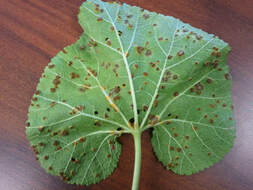 Watch for rust on hollyhock. This is the most common disease on hollyhock and can cause serious injury as leaves are progressively killed through the summer. Look for yellow spots on the surface of the leaves and orangish to brown pustules on the underside. Infections can also take place on stems and green flower parts. The first line of defense is to remove all hollyhock stalks, leaves and other debris in the fall and destroy them. Remove any infected foliage you see now. Just be sure the foliage is dry so you don’t spread the disease. Continue to remove diseased leaves as soon as they show spots. Try using a fungicide such as sulfur or myclobutanil (Spectracide Immunox or Fertilome F-Stop Lawn and Garden Fungicide) to protect healthy foliage. Note that sulfur may burn leaves if the air temperature is over 85 degrees within 24 hours of application. Follow label directions for timing and rate. (Ward Upham) 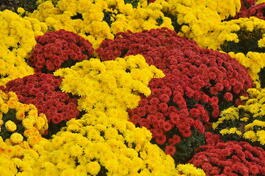 Though some garden mums do not require pinching back, most varieties will benefit. Pinching is done by removing the top inch of growth by pinching it between your thumbnail and forefinger. You can also use a scissors or even a pair of hedge shears. Pinching encourages lateral buds to break and grow resulting in a shorter, sturdier and fuller plant. The first pinching is usually done when the mums reach six inches in height. Remove about the top inch of growth. A second pinching should be done when the new growth from the previous pinch reaches about 4 inches. Cut the new growth down by about half. We may have time for one more pinch but maybe not as the last pinch should take place around July 4. Pinching later than July 4 can delay flowering resulting in a shorter time of flowering before frost kills the blooms. You may find a video on pinching mums helpful. It is found on our Kansas Healthy Yards website. (Ward Upham) 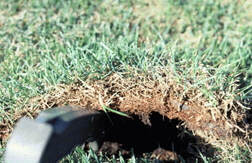 Thatch control for cool-season lawn grasses such as bluegrass and tall fescue is usually done in the fall but now is the time we should perform this operation for warm-season turfgrasses such as bermudagrass and zoysiagrass. Because these operations thin the lawn, they should be performed when the lawn is in the best position to recover. For warm-season grasses that time is June through July. Buffalograss, our other common warm-season grass, normally does not need to be dethatched. When thatch is less than one-half inch thick, there is little cause for concern; on the contrary, it may provide some protection to the crown (growing point) of the turfgrass. However, when thatch exceeds one-half inch in thickness, the lawn may start to deteriorate. Thatch is best kept in check by power-raking and/or core-aerating. If thatch is more than 3/4 inch thick, the lawn should be power-raked. Set the blades just deep enough to pull out the thatch. The lawn can be severely damaged by power-raking too deeply. In some cases, it may be easier to use a sod cutter to remove the existing sod. Bermudagrass will often come back if rhizomes remain in the soil. If not, you will need to start over with seed, sprigs or plugs. If thatch is between one-half and a 3/4- inch, thick, core-aeration is a better choice. The soil-moisture level is important to do a good job of core-aerating. It should be neither too wet nor too dry, and the soil should crumble fairly easily when worked between your fingers. Go over the lawn enough times so that the aeration holes are about 2 inches apart. Excessive thatch accumulation can be prevented by not over-fertilizing with nitrogen. Frequent, light watering also encourages thatch. Water only when needed, and attempt to wet the entire root zone of the turf with each irrigation. Finally, where thatch is excessive, control should be viewed as a long-term, integrated process (i.e., to include proper mowing, watering, and fertilizing) rather than a one-shot cure. One power-raking or core-aeration will seldom solve the problem. (Ward Upham)  Recent rains in certain areas of Kansas have resulted in the appearance of mushrooms in home lawns and landscape beds. Although mushrooms are often spectacular in size and color, most are relatively harmless to plant life. Some of these mushrooms are associated with arc-like or circular patterns in turfgrass called fairy rings. The ring pattern is caused by the outward growth of fungal mycelium. The mycelium forms a dense, mat-like structure in the soil that decomposes organic matter. This decomposition releases nitrate into the soil, which in turn stimulates the growth of the grass at the outer portion of the ring. This results in a dark green appearance of the grass at the margin of the ring. Unfortunately, the thick fungal mat formed by the fungus interferes with water infiltration. The fungus also may release certain byproducts that are toxic to the turf. This may lead to dieback of the turf close to the ring. Therefore, in some cases the ring is evidenced by a darker green color and in others, by a brown ring with the outside edge being darker green than the rest of the turf. Fairy rings are difficult to control. You can sometimes eliminate the ring by digging to a depth of 6 to 12 inches and 12 inches wide on both sides of the ring, refilling the hole with non-infested soil. Or you can try to mask the symptoms by fertilizing the rest of the lawn so that it is as dark green as the ring. This often isn't a good idea because it tends to promote other turf problems. Commercial people can use certain fungicides to control fairy rings but these products are not available to homeowners. See http://www.ksre.ksu.edu/bookstore/pubs/EP155.pdf for more info on these fungicides. Some mushrooms in lawns are not associated with fairy rings. These may be mycorrhizal (symbiotic association with tree roots) or saprophytic (live on dead organic matter such as wood, etc.) in the soil. Because some of these mushrooms are beneficial, you don't really want to kill them. Besides, a fungicide spray to the mushroom itself does little good. Remember the mushroom is simply the fruiting structure of the organism. Most of the fungus is below ground and inaccessible to the chemical. If mushrooms are a nuisance, pick them and dispose of them as soon as they appear. If there are too many for that to be practical, mow them off. Removing sources of organic debris from the soil can help if such is possible. Also, mushrooms tend to go away as soil dries. Patience may be the best control. Some of the mushrooms in the lawn are edible, but others are poisonous. Never eat mushrooms unless you are sure of their identity. (Ward Upham) 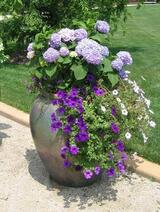 I have had several questions this spring on potting soils and how to choose the best potting media. Dr. Cheryl Boyer, our Nursery Crop and Marketing Specialist, has done extensive studies on potting soils and has written the following to help homeowners make a good choice. We will present her material is three parts or steps with one step each week. Step 1: What are You Using it For? Step 2: Understanding Major, Minor, and Specialty Components Step 3: Mixing and Managing Last week we covered Step 2. So, here is Step 3. (Ward Upham) Step 3: Mixing and Managing Knowing what you're working with and what you're trying to do with it will help you understand how to manage it in practical use. These materials may also listed on the ingredient list and it's helpful to know what to expect. · Lime: One special challenge we have in Kansas is that we have a lot of limestone around, which raises the pH of our soil and our water. You may notice that many bagged products include lime or limestone as a fertilization amendment. This is because most soil-less media components are very low in pH, or acidic, and they're trying to get the mix to be pH neutral (so that most nutrients are available for plant uptake). In Kansas, most of our soils are on the high pH, or alkaline, side. It is to our advantage to apply soil-less products that are low in pH because that will help to neutralize our native soil. We don't need the added limestone, but it's unlikely you'll find a product that doesn't have it mixed in. For sure, don't add more! · Fertilizer: As mentioned earlier, most bagged products have a "starter charge" of fertilizer. You won't need to add anything immediately, but within a few weeks you'll need to apply a water-based fertilizer (immediately available to plants) and/or a long-term slow-release fertilizer product. These usually come rated for months of use. A short-term product (3-4 months) may sound like it will last all summer, but if it gets really hot outside the pellets may release early (if temperature is the mode of operation). Combining a shorter-term product with a longer term one (8-9 months) may cover your needs for a longer time. · Wetting agent: Some products, like peat, are harvested and packaged in a very dry state and may need help retaining water when ready for use. This will likely be pre-mixed, though if you can tell it's very dry you may want to spread it in a wheelbarrow and mix in some water (and maybe your own re-wetting agent) until it's consistent. · Watering: Containers will need to be monitored for water more frequently than landscape beds, but they all need to be checked. This will vary in every situation, so you'll need to keep an eye on it until you understand how all of the components are functioning together. Potting media products are remarkably similar once you get past the packaging. Read the ingredient label (just like in the grocery store), find what you need for your application, and then choose the product that best meets your needs and your budget. Choose on price only after you've leveled the playing field of similar products. Got questions about an unusual component? Let me know—I love a good alternative material discussion. (Cheryl Boyer) |
AuthorsCynthia Domenghini runs the Horticulture Response Center in the Department of Horticulture and Natural Resources at Kansas State University. Other contributors include K-State Extension Specialists. Archives
March 2024
Categories
All
|
| K-State Research and Extension Horticulture Newsletter |
|

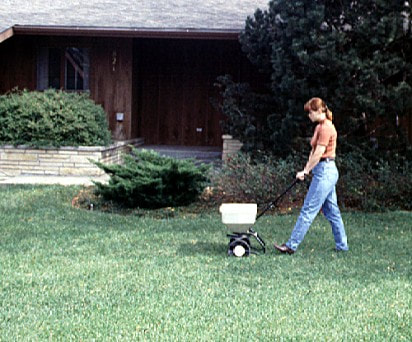
 RSS Feed
RSS Feed
